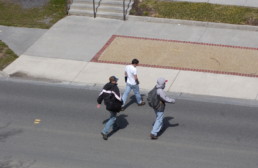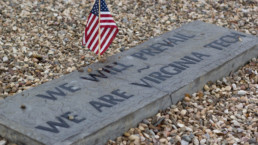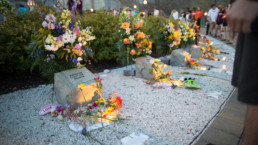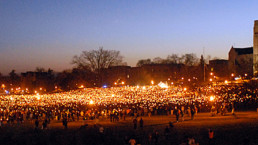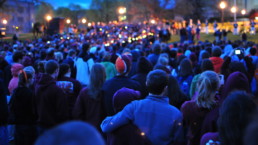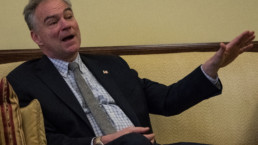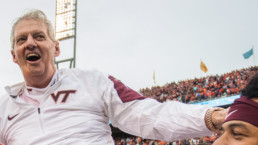A SURVIVOR’S RACE
It was just another day for Thomas Burnett as he mosied up to the cash register and paid for his cup of coffee like everyone else before him. As an emergency physician of 11 years at Carilion Roanoke Memorial Hospital, a pager was all that sat between him and the surrounding coffee-drinking regulars.
Ten years later, answering the call still feels like a freshly cut wound. Many memories have come and gone, but bottled up inside of Burnett lives the raw account of one fiercely persistent story — the day Virginia State Police Division Six SWAT team’s physician gears up as a first responder for the April 16 shootings.
“I remember one of our officers carrying out the student who had a tourniquet in place,” Burnett said. “We were helping direct where the students were going to go … Our primary concern at that point in time was to provide additional security because … we were getting a lot of reports from the students that there (was) more than one shooter.”
Virginia Tech’s campus security officials clotted around their first target building, West Ambler Johnston Hall. Jumping out of the car, Burnett recalls being the third SWAT team to arrive on scene just before the second shooting occurred and the chaos beating around him.
“I remember it being tremendously windy. I remember the flowers, the cherry blossoms had already started falling and were blowing around, so it seemed like there was snow,” Burnett said. “I was asked if we needed to have a helicopter on the scene to transport the victims to the trauma center, but the winds were so great that day that we couldn’t fly the helicopter … That’s why we ended up using a lot of ambulances and transporting to Montgomery Regional and New River Valley and moving patients from there.”
Ambulances were packed to the brim with emergency supplies, equipment and medical aids. Eventually, the students were lifted from campus to where they would spend their next days, weeks or months with healthcare professionals tending to their wounds, both superficial and deep.
Following emergency evacuation, Burnett and his team scoped the hallways and were accompanied with K9 dogs for optimal detection. His team didn’t rest until very late in the evening, walking the same hallways as the gunman moments after he committed suicide.
“I remember going into the building,” Burnett said, pausing to compose himself and wipe away his tears. “I remember coming out of the building and seeing a bike rack in front of the building with bikes, and we realized that most of those bikes weren’t going to be picked up and probably (were) never going to be picked up by the students.
“I can still see the bike rack and it represented just some horrible things that happened that day. Things are still hard to think about 10 years later.”
As a man of active military service, Burnett explains why nothing could have ever prepared him for the sights he witnessed on April 16.
“I have been in the military for 16 years; I have numerous overseas deployments, combat deployments, I worked with special operations in the past, and despite seeing all the things that I have seen in those environments, seeing that in a war zone is something you almost expect. But seeing that in an area where you have friends and family, in what is supposed to be a safe and protected environment, it feels very personal and it feels like something has been threatened that shouldn’t be threatened,” Burnett said. “I think that’s why it stings so much — because these were innocent people that started their day, a day we all relate to, thinking it’s just going to be another day at school…
“It’s unlike anything I have ever seen and hopefully isn’t like anything I’ll ever see again despite continuing to work in the trauma bay and continuing to work in the ER with the military.”
Along with weather complications, communication was shot between first responders and the hospitals who would be receiving patients later that day. With overwhelmed cell phone lines, direct communication became a luxury; EMS became Burnett’s middle man to the hospital.
Over at Montgomery Regional Hospital, its first patient was getting ready to be dropped off by a transportation system that most students frequently ride — Blacksburg Transit (BT).
Students evacuate campus as told by emergency personnel on April 16, 2007.Karl Falconer / Collegiate Times
Rescue squads from around Montgomery county wait outside of Burruss Hall at 1:45 p.m. on April 16, 2007.TEADORA ERBES / COLLEGIATE TIMES
A SAFE HAVEN FOR HOKIES
As
a Level I trauma center with a trauma disaster preparedness plan in place, Dee Hawthorne and Mike Hill had never in their wildest dreams anticipated using their training skills for a real-time massacre in the small town of Blacksburg, Virginia.
In 2007, Hill was the director of the Emergency Department at Montgomery Regional Hospital, and he remembers coming to work after the first two students were shot, one pronounced dead at the scene.
After one victim had jumped out of the window, escaping and breaking free, the student walked toward a BT bus that read “Hospital” on its electronic screen. After climbing inside the man was told he would be shuttled to the nearest hospital, but he was a lone passenger.
“The bus driver came through the door and said, ‘I got a kid out here who’s got a broken leg.’ OK,” Hill said. “And then it was on. Yeah, from that point it was one after another.”
Just as Burnett had recalled, Hill describes the day as cold and windy, but the secondary notice on his scanner about another incident over at Norris Hall was the ultimate red flag.
“It was kind of party on from there, from an ER perspective,” Hill said. “And that’s kind of when we knew. When we started hearing shutter on the scanner, that’s when we knew there was more to it than a jealous ex-boyfriend kind of thing.
“And you know that morning, I don’t even know what time it was, 8, 8:30, there was a gold alert call from the hospital which means it’s multi-system trauma or it’s something bad,” said Dee Hawthorne, who was the operating room clinical leader at Montgomery Regional Hospital on that day. “Our anesthesia people responded to that and that’s when the two victims were up in the ER. So at that point, after that was all done, we thought it was over.”
Both Hill and Hawthorne were largely unaware of the number of patients that would be brought to their hospital and fortunately had the exact amount of room for the patients that were shuttled through those double doors — 17 trauma bays for 17 emergency patients.
As a nurse for the surgical team, Hawthorne remembers going through supplies at an impossible rate. Blankets were wiped out, IV fluids were depleting, and her boss, the director of the OR, was in San Francisco, California, following along with TV broadcasts at her nearest airport.
As a trauma nurse, Hill recalls only having five or six trauma packets on hand that were pre-packaged for identifying patients in a quick and efficient manner. This meant that the staff would need to get creative for the remaining 11 or 12 patients, considering that many had been injured or swollen to the point of no recognition.
“We just didn’t have enough,” Hill said. “When the whole thing was said and done, we were making up arm bands and just putting names on them. We were writing on pillow cases and sheets what medicine we had given them, how much IV fluid we gave, because it was so chaotic.”
With a two-to-one patient to nurse system, Hill mentioned his concerns of a staff shortage, but everything seemed to pan out eventually. Adrenaline was flowing for both Hill and Hawthorne, who say they each made it well into the middle of the night before even taking a nap. Transitioning from 8-hour days, 18-hour shifts became habitual.
“I was putting monster needles in these kids to get blood work or X-rays, and pain medication and all of this stuff and I would look ‘em right in the eye and hold their hand and say, ‘You are going to be OK,’” Hill said. “We are going to call your folks, we are going to let them know that you are here. It’s going to be OK.”
The hospital reached maximum capacity, and for the first time since both Hawthorne and Hill had been working at Montgomery Regional, the hospital had to divert and all elective surgeries were cancelled as well.
Mandated by security officials, the hospital went under lockdown and is still under semi-lockdown today. Both nurses recall reporters and others impersonating doctors with lab coats, pretending to be police officers or trying to pass as a Virginia Tech student in order to go see the patients and wander the halls interviewing whomever they’d like. Now, there are few entry points that allow public access without a badge to formally identify yourself as a working professional.
Hawthorne says that the strict policies set in motion are partly due to the loose inmate of 2006 that killed one of their security officials and partly due to the April 16 shootings.
A mobile command center rushes towards the Drillfield to help the injured on April 16, 2007.KARL FALCONER / COLLEGIATE TIMES
A TIME TO GRIEVE
The healing process was grueling; it was a community stitched together by loose threads. Nearly everyone in the nation was, and still is, wrestling for answers. For starters, how do you put an event of such magnitude behind you?
“Up until recently we were in a unique club of school shootings and it was a club who we’d said, ‘Well, who wants to be in that club?,’” Hill said. “And then tragically it happens again and someone killed more people at another place. Somebody said, ‘I bet you’re glad you’re not No. 1 in that category anymore,’ and I said, ‘I could have been OK with being No. 1 in that category for a long time,’ because this means somebody else is doing the same thing that we did all over.
“So, you know it was a life changing thing for me, because in my directorial role then you were worried about numbers and money and where you are going to make productivity and where you are going to get this and this and this and after that I thought, ‘The little things are stop and smell the roses.’”
In a field where medical personnel are expected to be stoic, Hawthorne would put the emotions of her patients ahead of her own daily.
“You just kick in and do your job,” Hawthorne said. “As nurses, we all just do what needs to be done and take care of the patient and then afterwards, you know you can collapse and cry.”
And then there are others like Burnett who would prefer to keep themselves preoccupied, even after the fact.
“I try not to think about it a lot. It’s hard,” Burnett said. “I try to stay busy during that time. I find other things to try to keep my mind off of what happened that day and the memories I have. Just like this year, I planned active duty time so I will actually have time on active duty that will help keep me preoccupied.
“It’s weird, you get to the point where you just sense that the day is coming and you don’t really think about it,” Burnett said. “It’s not this conscious thing. And then you just start to say, ‘God, I’m moody today. I think I have an issue,’ and then I say, ‘Oh it’s the 16th, that’s what it is.’”
Raising a young family at the time, Burnett hasn’t ever felt there has been the right moment to talk to his children about his role with the SWAT team on April 16. Burnett, however, remembers returning home, wet and dirty, seeing his children watching TV off of their DVD player in the back of the car with his wife. The power had gone out, and this was the first time speaking to her since his brief visit to the coffee shop because the telephone lines were bogged all morning and night.
“I was tired. I was worn out. I was just physically and emotionally spent, and by the time I got home, we all went inside the house and slept,” Burnett said. “My wife woke me up the next morning to let me know they were going to try to find a hotel because the power was still out, and unfortunately with the rain and my boots and equipment, now that it was daylight, I had walked through water going into the house, and we had bloody footprints all over the carpet and all over the floors of the house because (of) the water from my boots … My wife was trying to let me sleep in, and when I woke up they had already gone to the hotel and I walked into the kitchen and it was a mess. It started to really settle in there, so I had some time to myself to try to think about things.”
Hill, who also had young children at the time, says this was the first time his wife and kids ever saw him cry.
“It was hard (crying),” Hill said. “It was hard watching my two year old tell me it was OK.”
Given the reputation of Virginia Tech students to dominate downtown Blacksburg, Hill couldn’t wait for annoying college kids to fill the streets again. “When it was well over and the dust had settled, a lot of the ER folks went to Sharkey’s at noon on Friday and we sat there in the middle, right when you walk in the door, we took a whole table and we just sat there and watched kids come in,” Hill said, as his voice began to break.
“You know the obnoxious kids who we can’t wait to go home in the summer because they take over downtown Blacksburg? … For that day, that’s all I wanted,” Hill said. “I wanted to see that they were moving on and they were getting better, that they were partying and having a good time. I think that was the big day for me that I needed … They didn’t have a clue who we were, we were just down there, that was our purpose — drink beer, eat chicken wings and watch obnoxious drunk Tech kids try to pick up girls.”
Above all hardships, the patient care in Montgomery Regional was exemplary. First bringing the marching band and then Tim Kaine, the hospital staff saw relatively little change in morale from their patients no matter how hard they tried to raise their spirits. Frank Beamer, however, was the beginning of a new perspective.
“I have some friends who knew coach Beamer and Bud Foster, and Bud Foster called me and I said, ‘Hey man, is there anyway you all could come by?’” Hill said. “Shoot man, when they found out that Beamer and Bud Foster and Charley Wiles were coming, girls were getting out of bed. They were fixing their hair, they were putting on makeup. That was like, it was the biggest deal that, ‘Oh coaches are coming. I’ve got to get up,’ and I’m like, ‘I’ve been trying to get you out of bed for three days.’
“And there is a picture of one of the girls that was in ICU looking out the window and if you look close at the picture she had tons of tubes and things hanging out, but that’s how much it meant to her to have something other than blah, so we did other things with them.”
Frank Beamer reflects on the first home football game after the April 16 shootings.
WHERE ARE THEY NOW?
Ten years ago, Hill, Hawthorne and Burnett lived the same unforgettable tale, all placed at different facets of the story. Through it all, they have each chosen to continue their profession at their same hospitals with most of their same co-workers on that day.
“I also have felt a part of the Virginia Tech family I think after that event,” Burnett said smiling. “It makes me feel like I have Virginia Tech blood so to speak, so for that it’s always had a special place in my heart.”
Hill and Burnett have actively educated people in regional and national conferences, making a point to mention the several new laws that have been set in motion and the significant progress that has been made with other trauma center facilities that are seeking advice on how to handle a shooting spree of this capacity. This included Hill traveling to Bethesda to give a speech for one of the biggest trauma centers in the United States that is known for treating presidents. Hill was surprised to learn that a facility of this caliber thought he was capable of offering assistance to their program.
“I show them a picture of our hospital and I take my little pointer and I go, ‘That’s my emergency room right there, 17 beds. It’s smaller than your closest, literally,’” Hill said. “The Director of Trauma says, ‘So let me understand. You guys took care of 17 gunshot victims? … Why can’t we take care of 6 car wreck victims?’
“And it kind of makes you feel a little good — you are a little small town hospital and you are hanging up there with the big boys. You know obviously they have better equipment and better facilities, but it was nice to hear that we did it right from people that big … I remember Katie Couric saying, ‘There is no way the hospital of this size can handle this tragedy,’ and we did pretty good. We did alright.”
In the end, Burnett believes that the tragedy could not have been controlled, no matter the agility of the response or the continuity of information about the shooter.
“I think everybody had a little piece of that puzzle but because of concerns over patient privacy and disclosure, it wasn’t all released and the puzzle pieces weren’t all put together until a later point in time, until it was already too late,” Burnett said.
For Christopher Flynn, director of Cook Counseling Center, the victims and survivors of Virginia Tech were in good hands. The first responders, he said, both on the frontline and behind the scenes, deserve to be recognized for their remarkable service.
“The first responders, the Virginia (Tech) rescue squad and the other responders from the community did amazing work,” Flynn said. “So the trouble that all human beings have is that we have an imagination, right? It’s pretty vivid. We can imagine what it was like in there or certainly talk to people who were in the building during that day.”
Since 2007, Hill and Hawthorne say that the hospital puts up banners for every school shooting, just as many other places did for them. Although heartache was inescapable, the warm embrace of of their colleagues, care packages from universities and heaps of handwritten letters offered something that no medication ever could — infinite love.
Joined by the many other unspoken heroes, Burnett, Hill and Hawthorne continue to trail in darkness, unsure of when their road to recovery will every truly cease.
“As first responders, sometimes it’s easier to ignore the memories than to really face them,” Burnett said. “I think that’s something that is starting to be looked at more and more from a psychiatric standpoint of how do we deal with the survivor’s guilt? Or how do we deal with the grieving process? What some people call PTSD to an emergency medicine nurse is just another day in the office. I mean it’s what we do everyday, so I think that we are just now coming to grips with the impact that that has on an individual over time, but historically I think that the way that most people in law enforcement and medicine have dealt with it is to maybe not deal with it.”
“You know, they have some of the kids coming in … for some of the staff to meet and greet and have some hors d’oeuvres, but a lot of my staff don’t want to do it,” Hawthorne said. “They don’t want to fall apart in front of these kids.”

